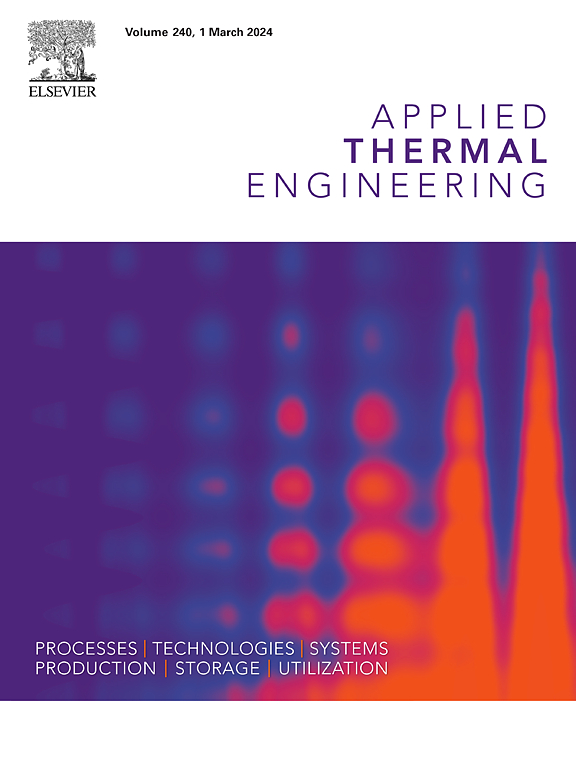钙环储能的流动和热化学动力学特性
IF 6.1
2区 工程技术
Q2 ENERGY & FUELS
引用次数: 0
摘要
基于致密颗粒流的钙环-热化学储能(CaL-TCES)是一种有前景的大规模长时间储能和工业脱碳技术。然而,CaL-TCES流化床反应器的能量-质量转换传递特性尚不清楚。本文采用计算流体力学-离散元法(CFD-DEM)结合综合传热和非均质反应模型,研究了CaL-TCES反应器的流态化和热化学行为。此外,系统探讨了工艺参数对颗粒分散、传热和蓄热性能的影响。结果表明:壁面区以颗粒传导和辐射传热为主,壁面区以反应热和辐射传热为主,壁面区以反应热和辐射传热为主;颗粒温度和CO2分压对反应强度和均匀性有显著影响。气泡相的高温和反应器底部的低分压使它们成为反应热点。此外,相对于粒径和壁温,气速对颗粒分散的影响更为显著。与其他气速相比,2.5倍流态化数既能达到温度与反应均匀性的平衡,又具有较高的换热系数、热效率和储能密度。小颗粒和低温环境促进高效均匀的传热,大颗粒和高温环境提高储能密度。该研究为优化反应器设计和运行,实现流化床反应器的高传热和储热效率提供了有价值的指导。本文章由计算机程序翻译,如有差异,请以英文原文为准。
Flow and thermochemical dynamic characteristics in calcium-looping energy storage
Calcium looping-thermochemical energy storage (CaL-TCES) based on dense particle flow is a promising technology for large-scale long-duration energy storage and industrial decarbonization. However, Energy-mass conversion transfer characteristics in the CaL-TCES fluidized bed reactor are unclear. In this study, the fluidization and thermochemical behaviors in the CaL-TCES reactor are investigated, using Computational fluid dynamics-discrete element method (CFD-DEM) coupled with comprehensive heat transfer and inhomogeneous reaction models. Moreover, the effects of process parameters on particle dispersion, heat transfer and thermal storage performance are systematically explored. The results show that wall-particle conduction and radiation are main heat transfer modes in wall zone, which dominates heat transfer pathway of the reactor, while central zone is governed by reaction heat and radiation. The reaction magnitude and homogeneity are significantly affected by particle temperature and CO2 partial pressure. High temperature in bubble phase and low partial pressure at the reactor bottom induce them to become reaction hotspots. Moreover, gas velocity has more pronounced effects on particle dispersion than particle size and wall temperature. Compared to other gas velocities, 2.5 times the fluidization number not only achieves a balance between temperature and reaction uniformity but also offers high heat transfer coefficient, thermal efficiency and energy storage density. Small particles and low-temperature environments promote efficient and uniform heat transfer, while large particles and high-temperature environments enhance energy storage density. This study provides valuable guidance for optimizing reactor design and operation to achieve high heat transfer and thermal storage efficiency in fluidized bed reactors.
求助全文
通过发布文献求助,成功后即可免费获取论文全文。
去求助
来源期刊

Applied Thermal Engineering
工程技术-工程:机械
CiteScore
11.30
自引率
15.60%
发文量
1474
审稿时长
57 days
期刊介绍:
Applied Thermal Engineering disseminates novel research related to the design, development and demonstration of components, devices, equipment, technologies and systems involving thermal processes for the production, storage, utilization and conservation of energy, with a focus on engineering application.
The journal publishes high-quality and high-impact Original Research Articles, Review Articles, Short Communications and Letters to the Editor on cutting-edge innovations in research, and recent advances or issues of interest to the thermal engineering community.
 求助内容:
求助内容: 应助结果提醒方式:
应助结果提醒方式:


